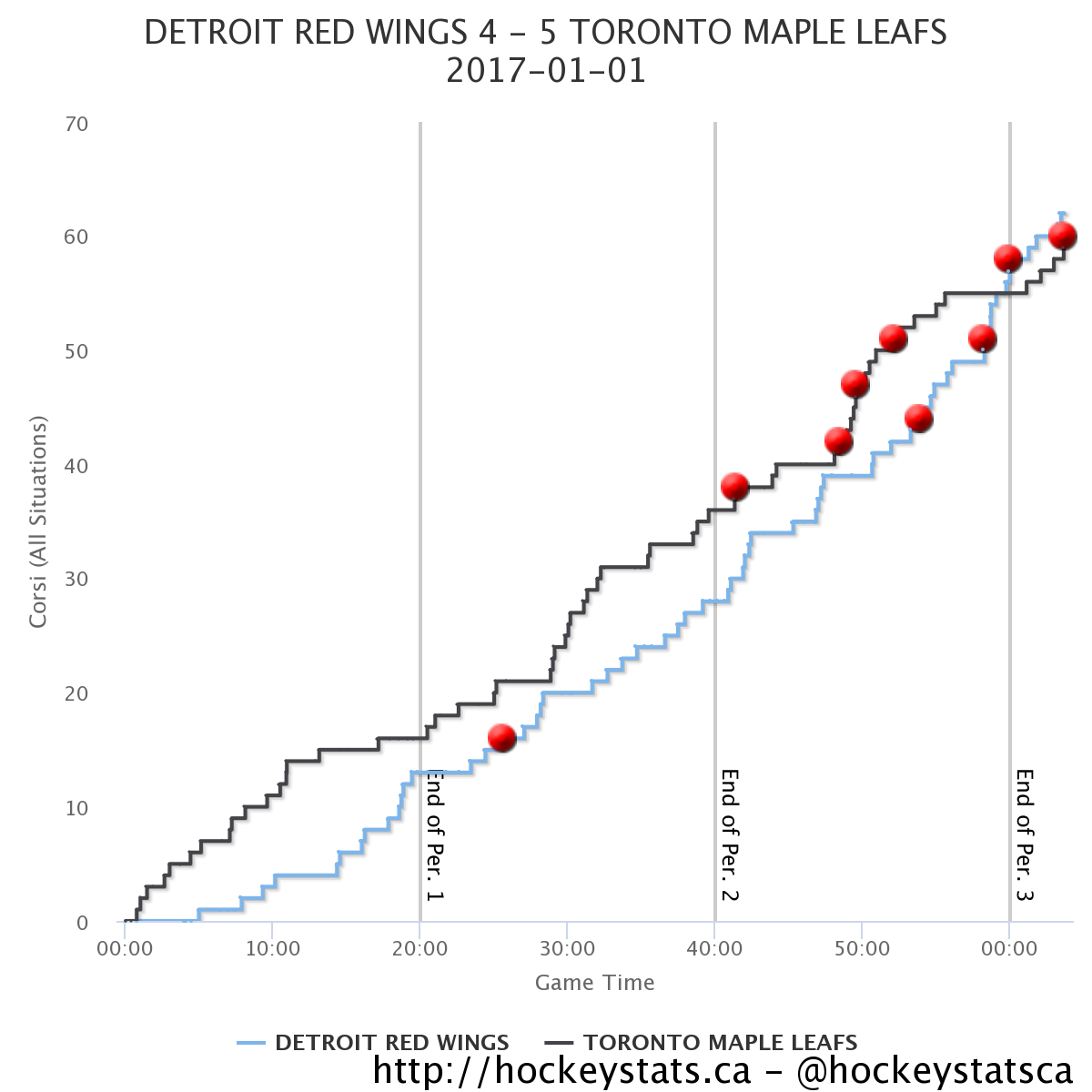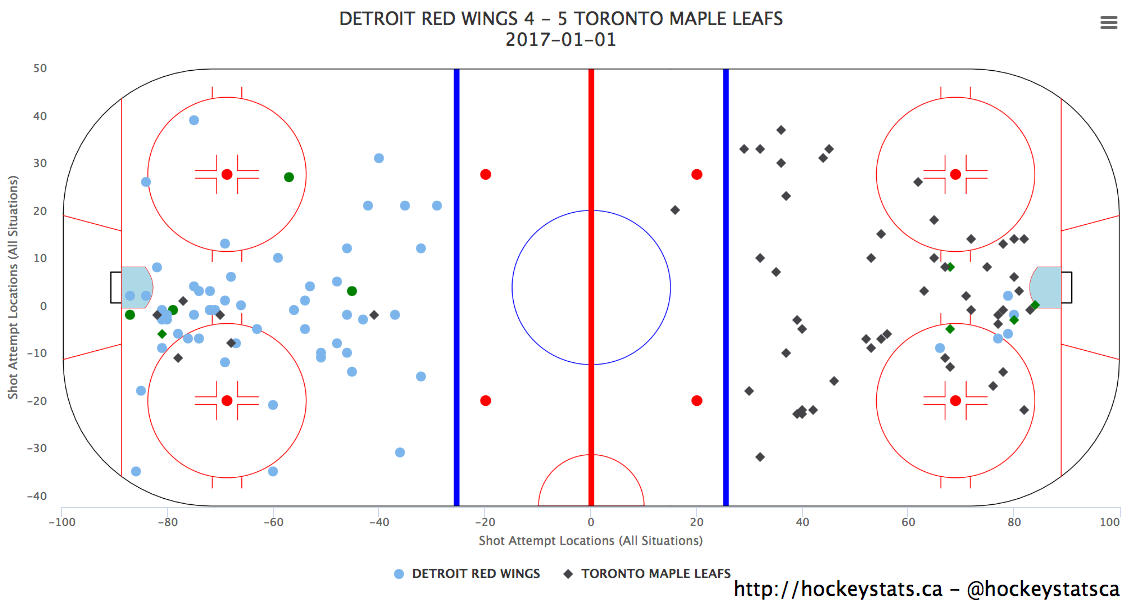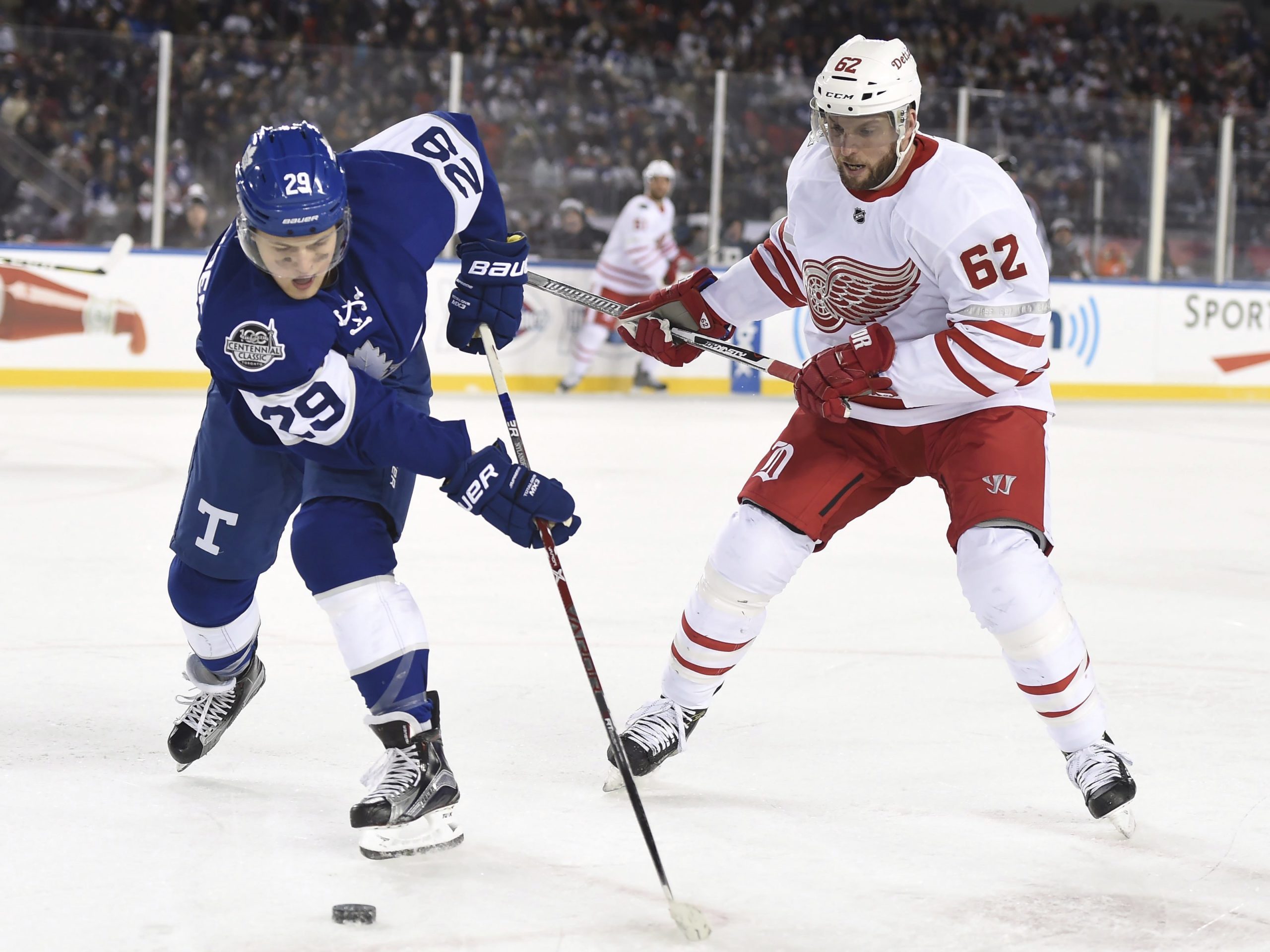Ten points on a memorable Centennial Classic game featuring a Leaf comeback and a Leaf collapse all in one, capped by the game-winning heroics of Auston Matthews:
1) Normally, the outdoor ice is poor with bouncing pucks and piles of snow, but the ice was actually hard and fast with no precipitation to interfere with the conditions. The game was still played tentatively in the first 40 minutes, which led one to believe it was going to be another low-event outdoor game. However, with many on the broadcast claiming it was the best ice at an outdoor event to date, it might have been nerves and a fear of making mistakes that was preventing the teams from going out and making plays.
2) The Maple Leafs controlled the play through the first part of the first, with some added momentum gained from an early powerplay, but they let Detroit slow things down and get back into the game in the second half of the first period and the Wings started to take control territorially.
3) The theatrics at the end of the game involving Marner and Matthews aside, the case could be made that William Nylander was the best Leaf over the course of the game. He certainly was over the first two periods. With the puck on his stick, he was able to skate uninhibited through three zones with ease, setting up the Leafs in the offensive zone seemingly at will. He was creating on his own on the forecheck and forcing turnovers; and when he’s doing that, he is deadly in transition. He was unlucky to get just a secondary assist after all of his efforts, as it probably should have been a multipoint day at the rink for him.
He set up Kadri with two identical feeds into the slot off the rush that Kadri wasn’t able to bury. He also manufactured another scoring chance in OT after a strip/sticklift just outside the blueline; he found Kadri with a ‘gimme’ pass on the tape from behind the net, and Kadri was visibly furious about not finishing it off with the game on his stick.
4) This was shaping up to be a boring, low-event game in which both teams were trying not to lose in front of a nervous crowd. While it is a millstone in the analytics community — often dismissed as folklore or nonsense — the Matt Martin fight with Steve Ott in the third period provided an obvious spark. From there on out, we witnessed an eight-goal explosion and more of a game of traded chances, which this Leaf team seems to thrive in. It was a barnburner of a finish; suddenly it became one of the better outdoor games we’ve seen after having all the makings of a dud through 40 minutes. That was not a coincidence.
“It’s pretty impressive that right after he scored that goal to get in the huddle where he kind of grabbed me and said ‘you pumped me up.’ For the guy who scored the winning goal in overtime in an outdoor game to say something like that is pretty special.”
– Matt Martin on the fight with Steve Ott and Auston Matthews’ reaction
5) The “but” in this game from the Leaf perspective was, of course, the matter of forfeiting a 4-1 lead in under seven minutes. There is a fantastic esoteric YouTube program hosted by one of Formula 1’s great journalists, Peter Windsor. Windsor often brings on Rob Wilson, a driving coach who quietly works with some of the greatest drivers in the world on the technique and mental applications needed to gain tenths and hundredths of a second over the course of a lap. For drivers that are already driving at their personal limits — at all times — it is like finding a needle in a haystack.
Wilson shared a great anecdote that seems like it is worlds apart from hockey but in fact could partially explain why a young team like the Maple Leafs can race out to big leads, only to have a mild case of pantshititus, allowing opponents back into games that should be over.
When a driver hits all of his marks and has either completed — or is in the middle of — a great qualifying lap or a really fast lap a during a race, there is a tendency to throw it off the very next corner (a known phenomenon). Mentally, the racer starts to stray from what got he/she there in the first place, trying too hard in certain areas and causing a load of trouble in others.
To use a racing analogy, the Leafs have often pulled out big leads and are putting in the fastest laps only to throw it off the track. It’s purely mental, and it will click for them eventually. They have the right coaching staff holding their hand while they figure it out (Babcock addresses it regularly). The ability to be ruthless and to close out games like the LA Kings or Chicago Blackhawks at their peak is a learned trait.
6) Auston Matthews was actually quiet for the better part of the game, but he put in a dominant third-period performance. It was another look at a very promising present — he is second in the league for goals behind Sidney Crosby — and a reminder that the future holds many more performances like this; players typically peak, statistically, between 25 and 26 years old. He’s only 19. Matthews put up 24 goals in 36 total games in the Swiss league last season and just dropped 20 in his first 36 NHL games.
7) Meanwhile, Connor Brown is showing more and more comfort and confidence alongside the supremely-skilled Matthews. This is clearly a player that has taken advantage of the Maple Leafs development programs to the fullest extent. He has a significantly better skating stride — he is more polished at using a clever change of pace to go along with a better understanding of how to buy himself time and space by controlling the defenceman’s feet (he can manipulate a defenceman to pivot or change direction, buying him time and extending possession). It is a good sign that an unsung player — who is getting shadowed by the big three a little bit — has a sense of the occasion. He is a born and bred Leaf fan, and the weight of the experience with the alumni the day before, to go along with the centennial/outdoor experience, wasn’t lost on him.
8) Perhaps it’s part Toronto sports fan skepticism that we’re looking for failure in big moments with the Leafs, but what was most encouraging about this game: The new core played their best in their biggest game together so far. Nylander was perhaps the best player on the ice for the duration of the game, creating a number of scoring chances, while Marner and Matthews obviously made the game their own (with a nod to Connor Brown) in the third period. For all of the above mentioned, this was the first time playing in the NHL under pressure of his magnitude. As Babcock said, this was particularly sweet because there was a lesson for the kids (the lost three-goal lead) and a Leaf win all in one.
9) The Leafs are now 9-4-4 in their last 17 and have a divisional playoff spot well within their grasp. The question is, is it sustainable? Most metrics point to the Leafs being able to keep this up, but, as we’ve observed over the past decade or so, wide-open hockey isn’t sustainable down the stretch. Stretch plays and long-bomb passes opportunities dry up. Open ice disappears. I still have concerns about the team’s ability to win tighter, 2-1 games that require patience – games where there is nowhere to skate and teams have their systems in lockdown mode. It should be a great test.
10) It needs to be reiterated: The consistently sterling play of Frederik Andersen has been unlike anything the Leafs have received between the pipes in approximately a decade. Very calm and square, he has the added ability to handle the puck and make a 100-foot tape-to-tape pass down the weak side of the ice on a change. Not something normally associated with the Leafs, it adds another layer that teams need to game plan against (Jeff Blashill mentioned this in the behind the scenes video before the game started, in terms of trying to keep pucks away from Andersen knowing he can get it back into hands of the Leafs’ skaters quickly). Consistency and quietude in net has settled the entire lineup and given the kids a safe place to play, much like Mike Babcock talked about the day he was hired. If Andersen can sustain this pace — which is very hard to do over a long season — he could be getting some Vezina votes towards the end of the season. The numbers are that good over a long enough time frame.
Game In Six
All Situations Shot Attempts

Shot Locations

Post Game: Mike Babcock
Mike Babcock reflects on Centennial Classic weekend, victory over Red Wings. Full transcript here:https://t.co/ttXuPWGlzY pic.twitter.com/hPJJYNhIfn
— Maple Leafs Hotstove (@LeafsNews) January 2, 2017


































